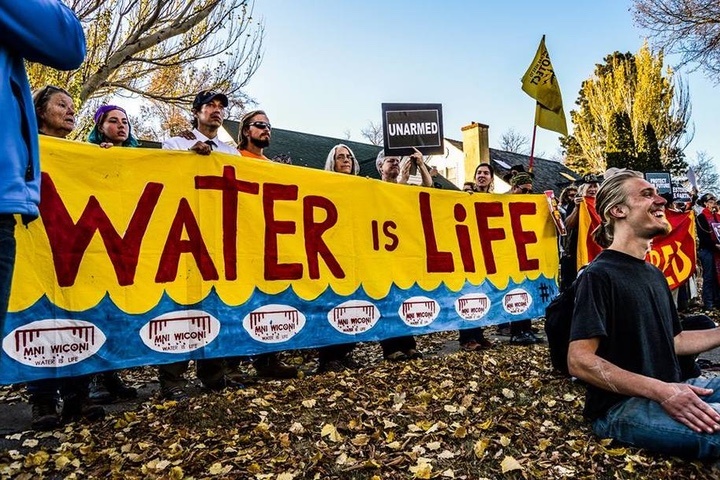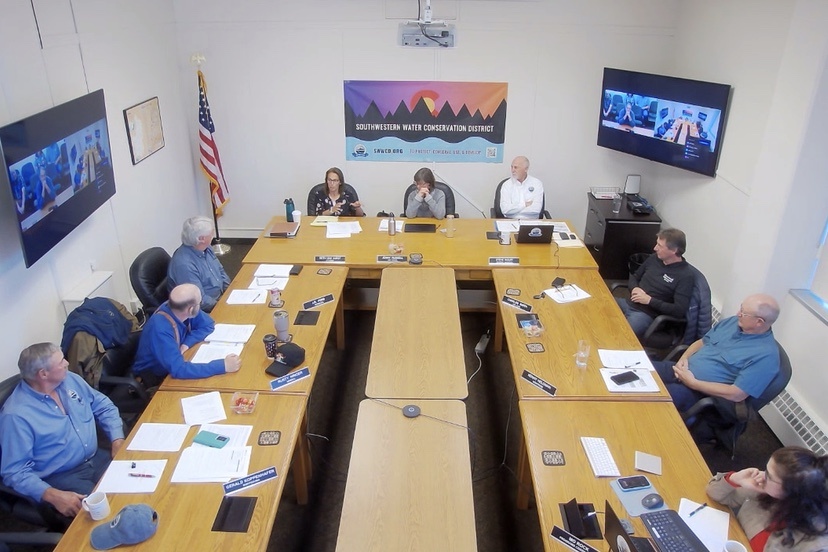Photo: Screenshot of the October 10 meeting of the Southwestern Water Conservation District Board of Directors.
I will be using two very similar acronyms in this editorial, and I hope readers do not confuse them. The Southwestern Water Conservation District — SWCD — serves 9 Colorado counties. The San Juan Water Conservancy District — SJWCD — serves the urban-suburban core of Pagosa Springs.
The difference is a “J”.
I concluded my recent editorial series with a brief discussion about Archuleta County’s ‘Strategic Planning’ process currently underway, led by consultants Jason Schneider and Rachel Barra. That process includes an effort to get input from Archuleta County residents regarding government priorities, and to that end, the consultants met with community members and also posted an online survey, open to the general public. (The survey appears to have ended, as of this morning.)
The consultants provided a list of 11 community issues to be considered as possible priorities… one of which was:
- Water Availability, Access, and Connectivity
As suggested in my previous editorial, the provision of drinking water in Pagosa Springs is not handled by the Archuleta County government, but rather, mainly by a separate government district: Pagosa Area Water and Sanitation District. PAWSD.
The Archuleta Board of County Commissioners certainly needs to be aware of how PAWSD handles this responsibility, but the BOCC is not directly involved in setting PAWSD policies and fees. Those decisions are made by the PAWSD Board of Directors and staff.
Disclosure: I currently serve as a volunteer on the PAWSD Board of Directors, but this editorial reflects only my own opinions, and not necessarily the opinions of the PAWSD Board or staff as a whole.
There are, however, other ‘layers’ of government involved in Colorado water policy, and those other water agencies and legislative entities occasionally find themselves in conflict, based on which constituents each is trying to serve, and on how much political power each is attempting to exercise.
One of the conflicts underlying water policy in Archuleta County concerns the 2008 purchase — by PAWSD, in cooperation with the San Juan Water Conservancy District (SJWCD) — of a 667-acre ranch north of downtown Pagosa Springs: the Running Iron Ranch. The ranch had cost the PAWSD customers about $9.2 million, with the money borrowed from the Colorado Water Conservation Board.
SJWCD additionally received a $1 million grant from CWCB, and contributed it to the ranch purchase.
Recently, the PAWSD Board has been discussing the idea of selling the ranch and getting its customers out from under the multi-million-dollar loan obligation. PAWSD staff is currently vetting companies to obtain a new appraisal of the property’s value. Interest in the property has been expressed by a couple of potential purchasers.
Meanwhile, at least one member of the SJWCD Board of Directors is strongly opposed to any such sale.
Yesterday morning, another water agency — the Southwestern Water Conservation District — held its bi-monthly meeting in Durango, and one of the items on the agenda was:
20. Potential Sale of Running Iron Ranch on the Initiative of the Pagosa Area Water and Sanitation District – Jeff Kane (SJWCD)
Jeff Kane is the Durango attorney retained by SJWCD to represent them on water matters.
The Southwestern Water Conservation District (SWCD) was created in 1941 by the Colorado General Assembly to “protect, conserve, use and develop the water resources of the Southwestern basin for the welfare of SWCD, and safeguard for Colorado all waters of the basin to which the state is entitled.”
SWCD is comprised of nine counties: Archuleta, Dolores, La Plata, Montezuma, San Juan, San Miguel, and parts of Hinsdale, Mineral, and Montrose. Each Board of County Commissioners appoints a representative to the SWCD Board of Directors, which meets every other month.
A mission to “protect, conserve, use and develop the water resources of the Southwestern basin” should certainly strike us as honorable, considering that “Water is Life” — as the protesters at Standing Rock reminded us in 2016.

We are fortunate, in Pagosa Springs, that mining operations and oil and gas development do not currently threaten our local water resources. The biggest threat to clean water is probably agricultural runoff.
And the threat of drought, of course.
During his presentation to the SWCD Board yesterday, attorney Kane questioned the process PAWSD is using to determine whether to sell the Running Iron Ranch.
“I’m an attorney, and I know enough [about this issue] to be dangerous. But I don’t have the background on this project that a lot of other folks do, so I’m going to do my best to convey some information, and brief you on some developments related to the San Juan Headwaters Project, also known as Dry Gulch Reservoir, and the ownership of the Running Iron Ranch by the San Juan Water Conservancy District as well as the Pagosa Area Water and Sanitation District.
“There are some quickly moving developments, so I’d like to brief the [SWCD] directors now.
“I don’t have any specific proposals or asks today. But Southwestern has been involved in this project since at least 1967…”
Attorney Kane is here referring to the establishment of Dry Gulch water rights by SWCD in 1967. Back in the 1960s, Colorado water districts were seeking to establish reservoir rights everywhere possible, but many of those rights have since been abandoned as impractical, for geographical or financial reasons.
The Dry Gulch water rights have, however, remained in effect, as “conditional” rights. Undeveloped rights. No funding currently exists, however, to develop the proposed Dry Gulch reservoir.
A previous PAWSD Board determined, back in 2003, that the community would be desperately short of drinking water by the year 2024, and that the Dry Gulch Valley, on the Running Iron Ranch, offered a prime location for a very large water reservoir. That same Board determined that the Pagosa Springs community could, and would, provide the money to build the reservoir — priced at one point at $357 million.
However, the PAWSD Board gradually took on new directors, and by 2013, the Board concluded that the data supporting a large reservoir was, in fact, faulty… that the reservoir was oversized and impractical… and that PAWSD had sufficient water resources, even in a drought scenario, through at least 2045. The construction of the Dry Gulch Reservoir was removed from the PAWSD long-term capital plan.
But PAWSD customers are still paying principal and interest on the loan.

